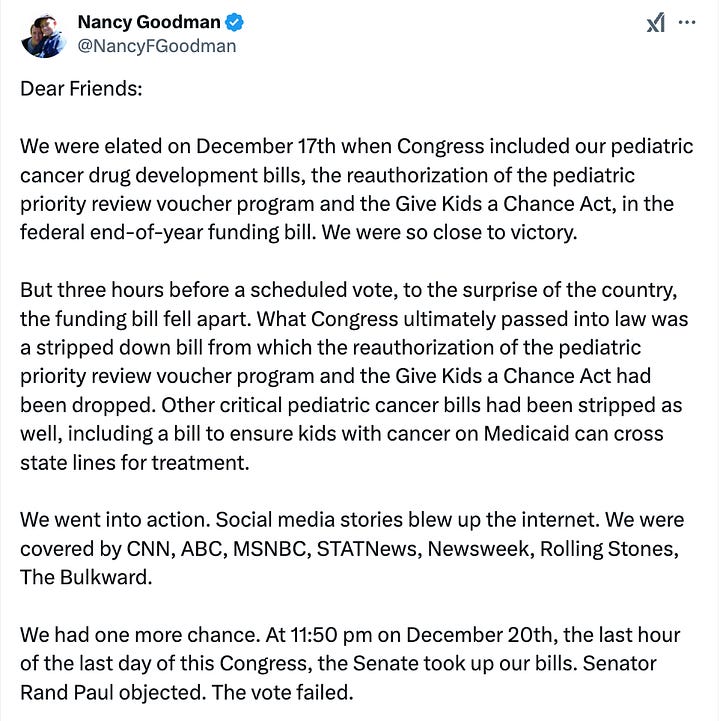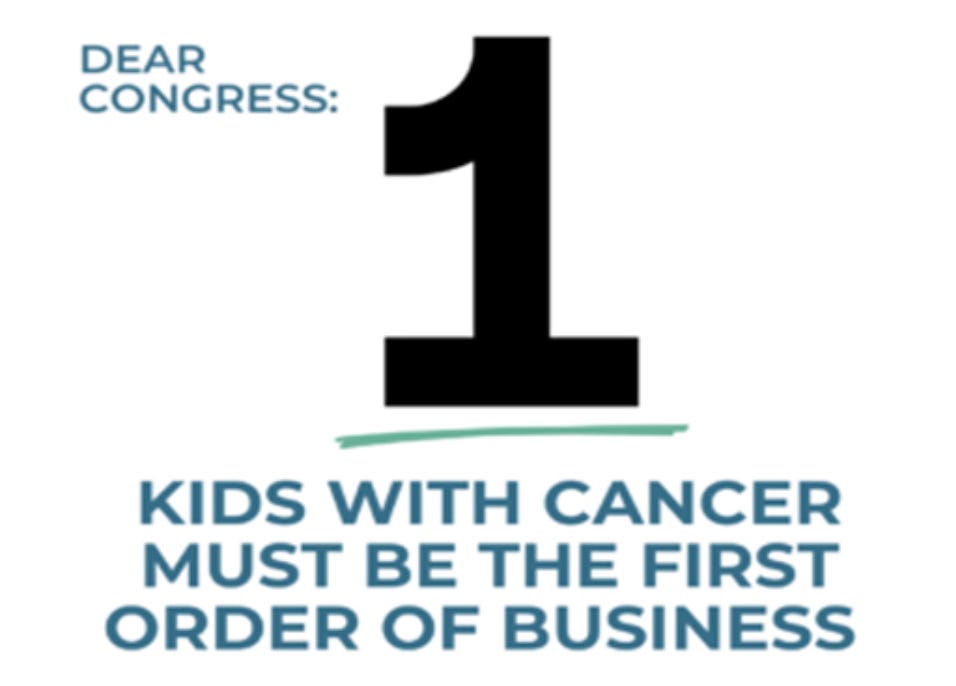If you care about the health and well-being of children with cancer, the shenanigans that occurred at the close of the 118th Congress deserve your full attention and understanding. Congress’s multi-act, end-of-session drama around the Continuing Resolution (CR) funding bill played out like a tragic theatrical way-off-Broadway performance – complete with missed cues, backstage meddling, and a disappointing final act where the most vulnerable were left out of the script.
Unfortunately, in this flawed production, there are real-life consequences related to keeping the government functioning and to advance key bipartisan measures. For children battling cancer and their families, this political drama is no abstract policy debate, as it has life-of-death consequences. Rather than a bipartisan success story ending, the initial script was literally stripped of key acts relating to pediatric cancer research and treatment that will force a full restart in the 109th Congress that begins tomorrow.
Pediatric Cancer: A Crisis That Demands Action
Pediatric cancer is not just a medical challenge; it is a heartbreaking crisis that steals childhoods, disrupts families, and forces parents into impossible choices. Despite bipartisan agreement on measures to address pediatric cancer, Congress largely failed to act and left behind critical legislation aimed at saving young lives. This is not just a failure of governance – it’s a moral failure that demands accountability, urgency, and correction.
Early year, an estimated 15,000 children under the age of 19 are diagnosed with cancer, and over 1,500 children are expected to die from the disease in 2024. Cancer remains one of the leading causes of death among children, and it differs dramatically from cancer in adults. Pediatric cancer includes leukemias, malignant brain and central nervous system (CNS) tumors, lymphomas, epithelial neoplasms and melanomas, and soft tissue and bone tumors. These cancers present unique challenges that require tailored research and treatment approaches.
Significant progress has been made in fighting pediatric cancer. As the AP’s Carla Johnson reports:
Nearly incurable 50 years ago, childhood cancer now is survivable for most patients, especially those with leukemia. The leading cause of cancer deaths in kids is now brain cancer, replacing leukemia.
Unfortunately, progress has not been universal. Survival rates remain heartbreakingly low, particularly for rare and aggressive cancers. Worse, recent data reveals that progress has stalled for Black and Hispanic youth and is exacerbating existing health inequities. Structural barriers to accessing high-quality care, socioeconomic disparities, underrepresentation in clinical trials, and new technology leave marginalized children even more vulnerable. This underscores why legislation addressing pediatric cancer is not only necessary – it is urgent.
What Was at Stake in Congress
The bipartisan package of pediatrics bills included in the initial year-end CR was designed to address the unique and complex issues involving pediatric cancer.
These bills addressed crucial gaps in research treatment, and access to care:
- Gabriella Miller Kids First Act: This reauthorization would continue funding for research on rare childhood cancers, birth defects, and other pediatric diseases. It was established in 2014 in honor of Gabriella Miller, a 10-year-old who advocated for pediatric cancer research before her death.
- Give Kids a Chance Act: This measure would have allowed the Food and Drug Administration (FDA) to authorize combination cancer treatments for children, addressing an outdated regulatory framework that only permits trials for single drugs.
- Accelerating Kids’ Access to Care Act: Designed to streamline Medicaid and CHIP care delivery across state lines, this bill aimed to improve families’ ability to access out-of-state care at regional centers of excellence for medically complex children, including those with cancer.
- Innovation in Pediatric Drugs Act: This would have given the FDA the authority to penalize companies failing to complete required studies on pediatric drugs, mirroring existing penalties for adult drugs.
- Creating Hope Reauthorization Act: This would have extended an FDA program that incentivizes the development of drugs for rare pediatric diseases through priority review vouchers.

The combination of pediatric cancer provisions or acts represented years of advocacy and a rare collection of bipartisan agreements to invest in children’s health. Together, they have the potential to transform pediatric cancer care and save lives. But when House leadership stripped the CR of contentious provisions, like a proposed congressional pay raise, they also removed these critical pediatric cancer measures – even though the bills had overwhelming bipartisan support.

[Link to Nancy Goodman’s tweet]
As Nancy Goodman, founder and executive director of Kids v Cancer, added in an interview with Newsweek:
I was just devastated, to be honest. The pediatric cancer community has spent 15 years to get to this point. This is the most significant bundle of pediatric cancer bills ever to be considered in Congress.
Congressional leadership’s decision to strip these provisions were an unfortunate and tragic choice. Goodman discusses the issue further on ABC News:
A Political Drama with Real-Life Consequences
The CR process is a legislative measure used in Congress to fund the government when Congress fails to reach an agreement to pass annual appropriations bills. The CR process has increasingly become a battleground for competing priorities, as legislators sometimes attach unrelated or controversial provisions in them to secure their passage in a “must-pass” bill. This is both a strength and a flaw of the system.
On the one hand, bipartisan measures like the pediatric cancer bills were included in the original CR to prevent them from being held up by Senate holds or filibusters.

There is no doubt, as I have discussed previously, that the process that prevented these important pediatric cancer bills from passing in the Senate is an example of why the filibuster should be reformed (but not abolished).
However, due to the increasing inability for the Senate to act, end-of-year bills like this year’s CR become important vehicles to ensure that important policy changes or extensions are not held hostage to narrow political agendas.
On the other hand, the CR process also creates opportunities for more controversial provisions to be added, such as a congressional pay raise.
In this case, House Republican leadership, under pressure from social media commentary and political attacks, such as those from Elon Musk, chose to strip the CR of all “nonessential” measures, including the important pediatric cancer provisions. For children with cancer and their parents, those five provisions represented the epitome of what is “essential.”
A Bipartisan Effort of Importance to the Lives of Children Undone
By stripping the CR of the pediatric cancer provisions out of the CR, advocates for children’s health had to scramble to beg the Senate to try to overcome Senate procedures and holds to get the individual pediatric cancer bills across the finish line. Amidst a great deal of finger-pointing, recriminations, and misinformation about who was at fault, advocates were met with limited success.
- A Victory: Sen. Tim Kaine (D-VA) successfully convinced Sen. Rand Paul (R-KY) to lift his hold on the Gabriella Miller Kids First Act, which had passed the House by a vote of 384-4 in March to allow the Senate to bring it up and adopt it by unanimous consent.
Sen. Kaine’s success was the one piece of good news.
Although some tried to dump blame on Senate Majority Leader Chuck Schumer (D-NY) for the failure of the pediatric cancer bill’s passage, Senate holds by Sens. Paul and Lee prevented them from coming to the Senate floor for months. The disappointing final act:
- Major Losses: Sen. Michael Bennet (D-CO) asked for unanimous consent to also pass the Give Kids a Chance Act in the Senate, but Sen. Paul chose, in this case, to object and block passage of the legislation.

The consequence for children battling cancer was a tragedy in multiple acts:
- If the original bipartisan CR had passed, all five pediatric cancer measures would have become law.
- If House leadership had not stripped the pediatric cancer provisions in the CR, they would have become law.
- Senate stand-alone versions of the bill had been held up for months by holds placed on their passage by Sens. Paul (and Sen. Mike Lee (R-UT) as well).
- One of those bills was cleared for final passage in the Senate when Sen. Paul released his hold on the Gabriella Miller Kids First Act extension, but passage of the Give Kids a Chance Act was blocked when Sen. Paul objected to bringing it up for Senate consideration.
- The other bills also failed to be passed due to the end-of-session time crunch and continued holds and lack of unanimous consent in the Senate.
The Human Cost of Inaction
For children battling cancer, legislative delays and inaction have real-world consequences. Families face unimaginable challenges navigating a patchwork health care system that often fails to meet their unique health care needs of children. The removal of funding affects not only research but also access to care and support for children and their families.
For example, the Accelerating Kids’ Access to Care Act is designed to help streamline Medicaid and ensure that children can get out-of-state care when they need it. When legislation like this is stripped or blocked from consideration by Congress, it impacts children and families who need time-sensitive medical care.
Here is a video by Kassidy Chenoweth about why this legislation is important to children like her.
Moving Forward: A Call to Action
The failure to pass these provisions underscores the how children are often an afterthought in Congress. While some congressional members are focused on appeasing political influencers and social media commentators, the lives of children battling cancer were sidelined. This must change.
Moving forward, we must demand that Congress revisit these bills early in the new session. Policymakers must prioritize the health of children rather than compound the harm to children.
Unfortunately, it is hard to be optimistic. For example, the so-called Department of Government Efficiency (DOGE) is an unelected body that does not serve the public, and yet, is being looked to by Congress for budget cuts. In a Wall Street Journal Op-Ed, its billionaire co-chairs, Elon Musk and Vivek Ramaswamy, argue that the DOGE “will help end federal overspending by taking aim at the $500 billion plus in annual federal expenditures that are unauthorized by Congress….”
In other words, having helped kill the authorization for some of the pediatric research and treatment provisions, the DOGE would then take the next step to recommend eliminating funding for provisions it killed, such as for cancer research and treatment.
Instead, we must demand that Congress take the stage, rewrite the script, complete these acts, and prioritize children’s health in the next session of Congress.

Kids deserve better from our policymakers, including from the non-elected bureaucrats in the DOGE. Let’s demand that Congress end the drama and replace it with acts of compassion and commitment that put children at the center and heart of its decisions.
